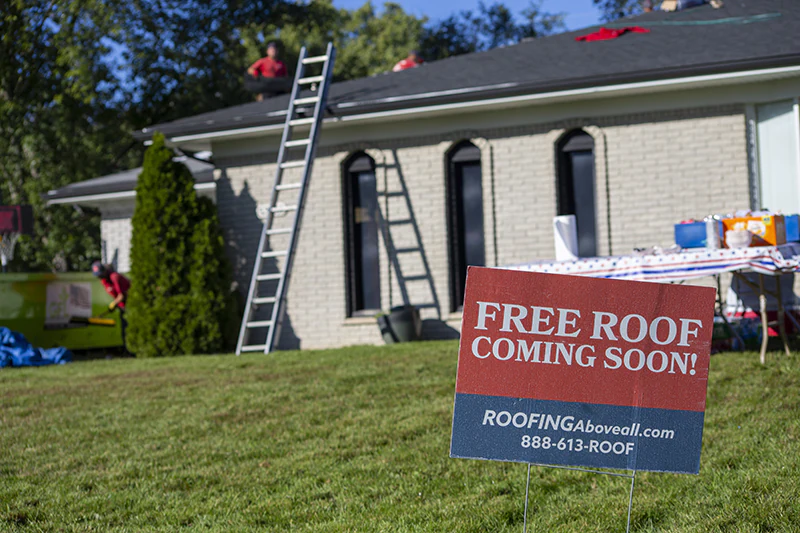
As early as the 90s, when my brothers and I started roofing, we saw firsthand the heartbreak of families struggling with a leaking roof. As my uncle used to say, “The roof protects not just the walls of a home but the heart of a family..” What happens when finances are strained and your family needs funds for a roof replacement? Everyone has had to revise their budgets as of late. Inflation has been challenging, to say the least, and it’s caused many of us to put off home improvement projects.The good news is that there are roof financing options to help families in situations like yours. Here’s your step-by-step guide to finding the right solution for your roofing projects.
Insurance Company Help: Let Them Pay First
Michigan weather can cause serious damage to your home’s roof. If your roof has been harmed by a storm, fire, or another insured incident, your homeowner’s insurance provider could pay for some or all of the cost of replacing your roof. Here’s how to take advantage of this.
- File an insurance claim: Contact your insurance agent directly to begin the process.
- Understand coverage: Policies vary – some cover the replacement cost, while others only pay the actual cash value based on your roof’s age.
- Ask if the insurance company pays upfront: Depending on the claim, they might cover the entire roofing project before you pay a dime.
If you’re unsure, we at Roofing Above All can help navigate the claim process and ensure your insurance company provides fair compensation.

How To Get Insurance To Pay For Roof Replacement – A Step-by-step Guide
Dealing with an insurance company to cover the cost of a new roof can feel overwhelming, especially if you’re already at your capacity caring for your family. However, you can maximize your benefits and reduce out-of-pocket expenses with the right approach. Here’s a step-by-step guide to navigating the process, understanding your options, and knowing when to seek professional help.
Understand Your Insurance Policy
Before contacting your homeowner’s insurance company, review your policy thoroughly. Key details to note:
- Replacement cost vs. actual cash value: Does your policy cover the full replacement cost of the roof, or will it only pay the depreciated value (actual cash value) based on your roof’s age?
- Covered perils: Damage caused by storms, hail, fire, or falling objects is often covered, but wear and tear typically isn’t.
- Deductibles: Check how much you’re responsible for paying out-of-pocket before coverage kicks in.
Inspect Your Roof and Document the Damage
Before filing a claim, have your roof inspected. Your homeowner’s insurance company might not pay for your roof insurance claim without an inspection from a roofing contractor. A reputable roofing contractor like Roofing Above All, can assess the damage and provide a detailed report, including:
- Photos or videos showing the extent of the damage.
- Estimates of the replacement cost or repairs needed.
- Notes about the roofing materials involved.
This documentation will strengthen your insurance claim and help ensure fair compensation.
File an Insurance Claim
Once you’ve reviewed your policy and gathered evidence, follow these steps to file your claim:
- Contact your insurance agent directly: Tell them about the damage and your intention to file a claim.
- Submit the necessary paperwork: This usually includes the inspection report and photos. Along with taking photos of the roof, document the date and time of the damage. Explain what happened so your insurance company knows you aren’t just trying to replace an old roof. Find newspaper articles documenting the event if a damaging storm moves through your neighborhood.
- Schedule an adjuster visit: Your insurance company will send an adjuster to assess the damage. Ensure your roofer is present during the inspection to advocate on your behalf.

Work With a Roofing Contractor Familiar With Insurance Claims
A contractor experienced in handling insurance can make the process much smoother. They can:
- Ensure the adjuster’s assessment is accurate and complete.
- Negotiate with the insurance company to cover all necessary repairs or replacement costs.
- Help you understand what the insurance company pays and what you’re responsible for.

Know When to Involve a Lawyer
In some cases, hiring a lawyer to assist with your claim might be necessary, especially if:
- The insurance company denies your claim without a valid reason.
- The compensation offered doesn’t match the scope of the damage or repair estimates.
- The claim process becomes delayed or complicated due to disputes.
A lawyer specializing in insurance coverage or property claims can help negotiate with the insurance company and ensure you receive what you’re entitled to under your policy.
Explore Additional Insurance Options
If your claim is partially denied or your policy doesn’t cover all costs, you may have alternative options to minimize expenses:
Supplemental claims: If new damage is discovered during the repair process, file a supplemental claim.
Get a second opinion from other roofing companies: Some roofing companies may have additional insights or strategies to help you maximize your claim.
Consult an independent adjuster: They can reassess the damage and advocate for a higher payout.
When to Negotiate or Appeal
If you’re unsatisfied with the initial offer, you can:
Negotiate directly: Provide additional documentation, such as a second opinion from another contractor.
Appeal the decision: Most insurance companies have an internal appeal process.
Seek mediation or arbitration: These services can help resolve disputes without going to court.
Final Thoughts
Working with your homeowner’s insurance company can help cover a significant portion of your roof replacement costs, but it requires preparation and persistence. By understanding your policy, documenting the damage, and enlisting the help of professionals like a Roofing Above All or hiring an attorney when necessary, you can ensure the process goes smoothly and you receive the compensation you deserve.
Still unsure where to start? Contact us, and we can guide you through every step of the claims process. Protect your home and your finances – don’t let your roof’s age or unexpected damage cost you more than it should.

Work With Roofing Companies Offering Financing
Many roofing companies understand that most homeowners don’t have cash on hand for significant home improvement projects. They often partner with financial institutions to provide flexible roof company financing options, such as:
- In-house payment plans allow you to break the total cost into manageable monthly payments with fixed payments and no surprise fees.
- Credit card payments: Some companies accept credit cards, which offer cash back bonuses or rewards to stretch your dollars further.
- Own lenders: They may partner with lenders to secure competitive interest rates for homeowners.
Check out the financing options that we provide, especially for urgent repairs.
Tap Into Your Home’s Equity
Your home’s equity can be a lifesaver when you need money for a new roof:
- Home equity loan: A one-time lump sum that’s great for projects with a clear total cost.
- A home equity line of credit (HELOC) is a revolving credit line for your roof and other home improvement projects.
- Cash-out refinancing: Refinance your mortgage to access extra funds, but watch for closing costs and ensure it fits your financial goals.
Consider Personal Loans
A personal loan is another option for those without sufficient home equity. Here’s what lenders will evaluate:
- Credit rating and credit history: The better your score, the lower the interest rates.
- Debt-to-income ratio: Lenders want to ensure you can handle the monthly payments.
- Yearly income: A consistent income boosts your approval chances.
Even with bad credit, you may still qualify, though you might face higher rates.
How to Get a Better Personal Loan for Your Roof Replacement
If you’re trying to figure out how to pay for a new roof, a personal loan might be a great option. But it’s important to know how to get the best deal, especially when it comes to interest rates and repayment terms. Don’t worry—it’s not as complicated as it sounds! Here’s a straightforward guide to help you secure a loan that works for you and your budget.
Understand What a Personal Loan Is
A personal loan gives you a lump sum of money to use however you need—like fixing that leaky roof. You pay it back in monthly installments, with interest, over a set period. The nice part? You don’t need to put up your home as collateral, so it’s less risky for you. But this also means the loan terms (like the interest rate) depend on things like your credit score and income.
How to Make Yourself Look Good to Lenders
Before you apply, it’s smart to make sure your finances are in good shape. Lenders look at things like your credit score and how much debt you already have compared to your income.
- Check your credit report. Mistakes happen, and errors can drag down your score. Fixing them might improve your chances of getting approved.
- Pay down some debt. If you can lower your credit card balances or other loans, lenders will see you as less risky.
- Be ready to show steady income. A regular paycheck helps prove you can make monthly payments.
Even small improvements in your credit or income can make a big difference in the interest rate you’re offered.
Shop Around for the Best Deal
Not all lenders are the same, so take some time to compare options. You can check out banks, credit unions, and online lenders. Credit unions, for example, often have lower rates and are more flexible if your credit isn’t perfect. Online lenders are super fast and convenient.
When comparing loans, look beyond just the interest rate. Ask about fees—some loans come with hidden costs like application or early payment fees. Also, find out how long it’ll take to get the money. If your roof is leaking, you probably don’t want to wait weeks for the loan to go through.
How to Get a Lower Interest Rate
The lower the interest rate, the less you’ll pay back over time. To score the best rate, start by showing lenders you’re a good gamble.
If you have good credit, let them know! Say something like, “I’ve worked hard to build my credit, and I’d like the best rate possible.” You can also mention that you’re shopping around—lenders don’t want to lose your business to someone else.
Some lenders offer discounts if you sign up for automatic payments, so ask about that. And if you’ve gotten a better offer elsewhere, don’t hesitate to bring it up. Say, “I’ve been offered X% by another lender. Can you match or beat that?”
Talking to Lenders Without Stress
Talking to loan companies doesn’t have to be intimidating. Think of it like any other big purchase – you’re just asking for the best deal. Be honest about your situation and ask questions if you’re unsure. For example:
- What’s the total cost of the loan, including fees?
- Are there penalties if I pay off the loan early?
- How long will it take to get approved?
Most lenders are happy to explain things if you ask. And if one lender doesn’t feel right, move on to the next – it’s your money, and you should feel comfortable.
When to Ask for Help
If the loan process feels confusing, it’s okay to ask for help. A financial advisor or credit counselor can explain the terms and help you figure out what works best for your budget. Friends or family members with experience in loans might also be able to guide you.
Be Smart About Repaying the Loan
Once you’ve got the loan, make a plan to pay it back. Stick to the schedule so you don’t hurt your credit score. If you get a little extra cash, like a bonus at work or a tax refund, think about using it to pay down the loan faster. The quicker you pay it off, the less interest you’ll owe.
Bottom Line
Getting a personal loan for your roof doesn’t have to be overwhelming. By understanding your options, preparing your finances, and negotiating for better terms, you can make this process work for you. Take your time, ask questions, and don’t settle for a deal that doesn’t feel right. With the right approach, you’ll have your new roof and a manageable payment plan in no time.
If you’re still unsure where to start, reach out to a trusted advisor or a friendly lender who can walk you through it step by step. You’ve got this!
What is a Home Equity Loan?
A home equity loan is a way to borrow money by using the value of your home as a guarantee. It’s sometimes called a second mortgage because, like your main mortgage, the loan is tied to your property. This type of loan can be helpful if you need a large amount of money for a big expense, like fixing or replacing your roof, after you’ve built up equity in your home.
How Does It Work?
Think of your home’s equity as the part of your house that you “own” outright. For example, if your home is worth $300,000 and you still owe $200,000 on your mortgage, you have $100,000 in equity. A home equity loan allows you to borrow a portion of that equity, usually up to 80–85% of your home’s value, minus what you still owe on your mortgage.
Once approved, you’ll get the loan as a lump sum of money. You then pay it back in monthly installments, with interest, over a set period, like 10, 15, or even 30 years. The payments stay the same each month, so it’s easier to plan your budget.
Why Use a Home Equity Loan for a New Roof?
If your roof needs replacing and the cost is more than you can handle upfront, a home equity loan might be a good solution. Since the loan is tied to your home, the interest rate is usually lower than other types of loans, like personal loans or credit cards. It’s also ideal for big projects because it lets you borrow a larger amount of money.
What Do You Need to Qualify?
To get a home equity loan, you’ll need to show that you have enough equity in your home. Most lenders require that you’ve paid off at least 15–20% of your home’s value. They’ll also check your credit score, your income, and how much debt you already have. If your monthly debt, including the new loan, is too high compared to your income, the lender might not approve your application.
What Should You Consider Before Applying?
A home equity loan is a big commitment, so it’s important to think it through. Since your home is used as collateral, you risk losing it if you can’t make the payments. There are also fees and closing costs that come with the loan, which can add to the total amount you owe.
It’s also a good idea to use the loan for projects that add value to your home, like a roof replacement, rather than something less essential. That way, you’re protecting your investment and possibly increasing the value of your property.
Are There Alternatives?
If a home equity loan doesn’t seem like the right choice for you, there are other options. For example, a home equity line of credit (HELOC) works more like a credit card, giving you access to funds as you need them instead of a lump sum. Another option is cash-out refinancing, where you replace your current mortgage with a larger one and take the extra money in cash. If you don’t have enough equity in your home, a personal loan might work, but it may come with higher interest rates.
A home equity loan can be a smart way to pay for a new roof if you’ve built up equity in your home and you’re confident you can make the monthly payments. Take the time to understand your options, compare lenders, and decide what’s best for your situation.

Save Money Where You Can
Replacing a roof is a significant expense, but there are smart strategies to reduce costs without sacrificing quality. Even if your budget is tight, these tips can help you save money while ensuring your family stays safe under a solid roof.
Choose Cost-Effective Roofing Materials
The type of roofing materials you choose significantly affects the cost of your roof replacement. Here’s how to balance cost and durability:
- Asphalt shingles: Affordable and versatile, they are a popular choice for most homeowners.
- Metal roofing: Slightly more expensive but long-lasting and energy-efficient, saving you money on cooling costs.
- Tile roof: Costlier upfront, but it can outlast other options by decades, reducing long-term repair costs.
You can contact us and ask about material options that fit your budget and the ever-changing Michigan climate.
Take Advantage of Discounts and Incentives
Some roofing companies and financing providers offer:
- Seasonal discounts: You might save more by scheduling your project during slower months for contractors.
- Cash back bonuses: Certain roofing company offers include reward programs for timely or upfront payments.
- Rebates or tax credits: Depending on where you live, you could qualify for state or federal incentives, especially for energy-efficient roofing options, insulation and roofing ventilation.
Extend Your Payments with Flexible Plans
If paying upfront is not an option, ask your roofing contractor about roof financing or payment plans. By spreading out costs over time, you can tackle the project without draining your savings. Look for plans with:
- Fixed payments to keep your monthly budget predictable.
- Low interest rates for homeowners with good credit.
- No early repayment penalties, allowing you to pay off the loan faster if your financial situation improves.
Prevent Additional Damage to Save on Repairs
Delaying a roof replacement can lead to water damage, mold, and higher repair bills. Addressing the problem quickly can help you save money in the long run. Here’s how:
- Inspect your roof regularly: Catch minor issues before they escalate.
- Seal temporary leaks: A reputable contractor can provide emergency fixes until you’re ready for a full replacement.
Bundle Other Home Improvement Projects
If you’re planning other renovations, consider bundling them with your roofing job. Many contractors offer discounts for handling multiple home improvement projects simultaneously, which can reduce labor and material costs.
Reuse and Recycle Where Possible
In some cases, portions of your existing roof may still be usable. Discuss with your contractor whether parts of your old roof can be salvaged or repurposed. Additionally, recycling materials like shingles or tiles can save on disposal fees and might even earn you a rebate in certain areas.
Negotiate Closing Costs and Additional Fees
When financing through a roofing company or a lender, watch out for closing costs and transaction fees. These can add hundreds or even thousands of dollars to the project. Ask about waivers, reductions, or incentives to offset these expenses.
Maintain Your Roof to Save on Future Costs
Once your new roof is installed, regular maintenance can extend its lifespan and prevent future expenses. Here’s how to stay ahead:
- Clear gutters and downspouts to avoid water pooling.
- Inspect after major storms for damage.
- Schedule annual check-ups with a reputable roofing contractor.
Explore Other Creative Options
When conventional options aren’t available, get resourceful:
- Credit card payments: If you have a card with low interest rates or rewards, this could be a quick fix.
- Government assistance programs: Check if there are local or federal grants for home repairs.
- Ask your roofing company: Some roofing contractors offer unique programs to help families in emergencies. Roofing Above All is known for helping homeowners in Metro-Detroit. – CLICK HERE

Don’t Let a Leaky Roof Become a Bigger Problem
A leaking roof isn’t just an inconvenience—it’s a risk to your home and health. The sooner you act, the less you’ll spend on damage control. Whether it’s working with your insurance company, tapping into roof financing options, or partnering with a reputable roofing contractor, there’s a solution for your situation.
Our uncle always said, “Every roof we fix keeps a family safe.” Now, it’s our turn to help you find the right way to pay for your new roof – without breaking the bank.
Start Today
Explore our financing options, and take the first step toward protecting your home. Your family deserves a safe and dry place to live. Let’s make it happen!